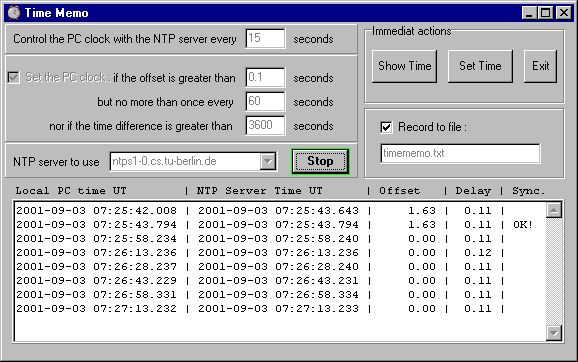|
Time Memo est un logiciel pour périodiquement contrôler
le décalage entre l'heure de votre ordinateur et celle donnée
par un serveur NTP. Il est également possible d'ajuster l'horloge
de l'ordinateur.
Comme tout est inscrit dans un fichier il est ensuite facile d'obtenir
la correction à appliquer ainsi que la marge d'erreur sur
l'heure de vos observations.
|
Time Memo is a software to periodically control the time
offset between your computer and a NTP server and eventually adjust
the computer clock.
As all the information are logged to a file it is easy to find
afterward the correction to apply to your observations as well as
the error box.
|
|
Télécharger :
- Version Windows 95/98/Me/NT/2K (245Kb)
- Version Linux x86 (241Kb) voir
également la partie Installation pour les runtimes Kylix.
- Code source Delphi6/Kylix (32Kb)
Time Memo est un Logiciel Libre (free software), il est distribué
selon les termes la License
Publique Générale GNU Version 2.
Le code source pour le composant Synapse est à : http://www.ararat.cz/synapse/
Des copies gratuites des compilateurs Delphi 6 ou Kylix sont disponibles
sur la page web de Borland : http://www.borland.com
Installation :
- Windows : copier timememo.exe et timeserver.lst
dans n'importe quel répertoire.
- Linux : copier timememo, tm et timeserver.lst dans
n'importe quel répertoire.
Il faudra certainement adapter le script tm pour indiquer la localisation
des librairies runtime.
Si vous n'avez jamais installé d'application Kylix, il faut
aussi installer les librairies runtime depuis : http://www.astrosurf.com/astropc/kylix/kylixruntime.tar.gz
Si vous n'avez pas Qt 2.2.4 il faut également l'installer
:
http://www.astrosurf.com/astropc/kylix/libqt224.tar.gz
Veuillez l'installer dans un autre répertoire que votre version
actuelle de Qt.
Mode d'emploi :
Il faut bien sur connecter votre ordinateur à Internet avant
de lancer le programme:
L'utilisation est très simple, il suffit de choisir la fréquence
de rafraichissement et d'indiquer si vous voulez ajuster l'heure
de la machine.
Quand tout est près appuyer sur le bouton "Start"
Toutes les informations sont consignées dans un fichier que
vous indiquez.
Les actions immédiates sont disponible à tout moment,
également pendant l'enregistrement normal.
La configuration est sauvegardée en sortant du programme.
Pour ajouter un nouveau serveur NTP il suffit d'editer le fichier
timeserver.lst.
Vous trouverez une liste de serveur à jours à :
http://www.eecis.udel.edu/~mills/ntp/servers.htm
Options de la ligne de commande :
- -s : débute immédiatement l'enregistrement en
utilisant les paramètres précédemment sauvegardés.
- -d : s'execute comme démon et débute immédiatement.
(sous Windows il faut utiliser Ctrl+Alt+Del pour l'arrêter).
Remarques :
Si vous utilisez un firewall il faut autoriser le trafic sur le
port 123.
Le détail du protocole SNTP est disponible dans RFC-1769.
|
Download :
- Version Windows 95/98/Me/NT/2K (245Kb)
- Version Linux x86 (241Kb) see also
the chapter Installation concerning the Kylix runtime.
- Source Code Delphi6/Kylix (32Kb)
Time Memo is free software, it is distributed under the terms of
the GNU General Public
License, Version 2.
The source code for the Synapse component is at http://www.ararat.cz/synapse/
Free copy of the Delphi 6 or Kylix compiler are available from the
Borland web page :
http://www.borland.com
Installation :
- Windows : copy timememo.exe and timeserver.lst to
any directory.
- Linux : copy timememo, tm and timeserver.lst to
any directory.
You probably need to update the shell script tm to reflect the location
of the runtime library.
If you never run a Kylix application you need to install the runtime
from :
http://www.astrosurf.com/astropc/kylix/kylixruntime.tar.gz
If you don't have Qt 2.2.4 you must also install :
http://www.astrosurf.com/astropc/kylix/libqt224.tar.gz
Please install in another directory than your actual Qt version.
Instruction :
Connect your computer to the Internet and run the program.
Usage is straightforward, simply select the query rate and if you
want or not to adjust your computer clock.
When ready press the "Start" button.
All the query and action are logged to the file you indicate.
The "Immediat action" are available at any time, even
during normal recording.
The setting is saved when you exit the program.
To add a new NTP server simply edit the file timeserver.lst.
Look at http://www.eecis.udel.edu/~mills/ntp/servers.htm
for more server address and up to date information.
Command line options :
- -s : start immediately the recording using previously saved
setting.
- -d : run as daemon and start immediately.
(on Windows use Ctrl+Alt+Del to kill it).
Remarks :
If you use a firewall you must authorize traffic on port 123.
SNTP protocol details are available in RFC-1769.
|

